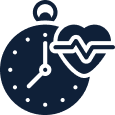What is a cardiac resynchronisation therapy (CRT) / biventricular pacemaker (BiV)?
CRT is a type of pacemaker system comprising of highly sophisticated wires and a generator (which is also the battery unit). CRT is also referred to as biventricular pacemaker. In most cases, it is designed for use in people with a weak heart muscle (Cardiomyopathy) and left ventricular (LV) dyssynchrony. The left ventricle is the main pump that delivers oxygenated blood to your body. It is designed to pump most efficiently in a quick and coordinated manner through a network of electrical wires. The two main branches of the electrical system coordinating the pumps are the right and left bundle branches.

When these electrical wires coordinating the LV is affected, it leads to poor coordination within the chamber, which is called dyssynchrony. It is most often related to block across the left bundle branch (LBBB).

Dyssynchrony leads to reduced pump efficiency which can affect people’s heart function, exercise capacity and cause feel short of breath. CRT may also be recommended in people with cardiomyopathy to prevent dyssynchrony due to high amount of pacing in the right ventricle.
The CRT system electrically coordinates the left ventricle to pump blood more efficiently. The pacemaker is not intended to fix irregular or fast rhythms. CRT can be incorporated into a defibrillator system in many cases. Medications are used in conjunction with pacemakers to safely control fast abnormal rhythms.
The main difference between a standard pacemaker and a CRT system is the left ventricular (LV) lead. This special lead is placed on the left side of the LV and aims to coordinate the left ventricular electrical system by pacing from both sides. The electrical impulses are triggered simultaneously from the standard pacemaker lead on the right side and the LV lead on the left side. The lead is placed by accessing a small vein that traverses the outside of the heart called the coronary sinus.

Not all people will have suitable veins to have an LV lead. In some cases, the LV lead is immediately next to an important nerve (Phrenic) limiting it’s use. The phrenic nerve supplies your breathing muscle which can inadvertently be stimulated leading to hiccup type feeling at times. If this occurs, settings can usually be adjusted to overcome the issue.
In some cases, the LV lead may have to implanted by cardiac surgeons on the outside of the heart. This is called an epicardial LV lead and then connected to your existing pacemaker. An epicardial LV will require a separate procedure.
Refer to the pacemaker and defibrillator sections for more information.
Please contact the rooms if you have any questions or concerns at any time.
In recommending this procedure your doctor has balanced the benefits and risks of the procedure against the benefits and risks of not proceeding. Your doctor believes there is a net benefit to you going ahead. This is a very complicated assessment.




